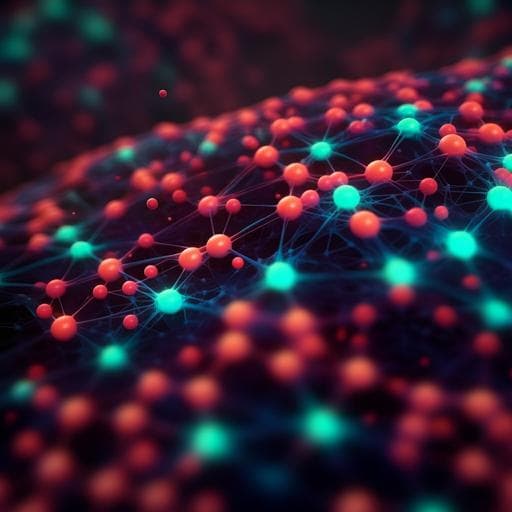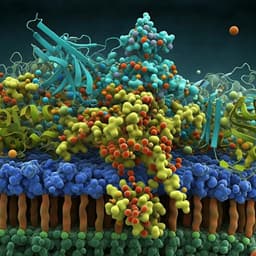
Medicine and Health
Development of a novel testis-on-a-chip that demonstrates reciprocal crosstalk between Sertoli and Leydig cells in testicular tissue
S. Park, M. G. Kook, et al.
Discover the groundbreaking development of a 3D multicellular testis-on-a-chip platform created by Se-Ra Park and colleagues. This innovative model intricately mimics the interactions between Sertoli and Leydig cells, enhancing our understanding of spermatogenesis and reproductive toxicity screening.
~3 min • Beginner • English
Introduction
Spermatogenesis in the seminiferous tubules relies on coordinated interactions between Sertoli cells, which form the blood-testis barrier and provide trophic support, and Leydig cells, which produce testosterone. Disruption of this crosstalk can lead to male reproductive disorders such as cryptorchidism, hypospadias, and hypogonadism. Traditional 2D monocultures and many 3D models inadequately recapitulate the multicellular complexity and dynamic endocrine communication of human seminiferous tubules, with most prior systems relying on animal cells or lacking functional Sertoli–Leydig interplay. The study aims to develop a human testis-on-a-chip that emulates reciprocal endocrine signaling between Sertoli and Leydig cells within a multicellular, structurally relevant 3D platform, and to create a sensitive biomarker-based readout for male reproductive toxicity.
Literature Review
Prior in vitro models for testicular function include 2D monocultures and 3D/organoid systems; however, many use animal cells and fail to capture human-specific multicellular interactions and endocrine crosstalk. Ex vivo microfluidic platforms using mouse testis tissue supported spermatogenesis and testosterone secretion but suffer from high cost and variability. Mouse cell-based microfluidic chips formed spheroids responsive to testosterone yet did not represent the human seminiferous architecture. A human multi-organ chip linking liver and testis spheroids modeled systemic interactions but lacked explicit Sertoli–Leydig reciprocal signaling. Overall, existing platforms do not adequately model the human seminiferous tubule’s compartmentalization and dynamic endocrine interplay.
Methodology
Human testicular cells: Normal testicular tissue was obtained with informed consent (IRB: 1044396-202106-HR-118-01) from a patient undergoing bilateral orchiectomy with complete spermatogenesis. Tissue was minced and digested in DMEM with 10% FBS and collagenase I (250 U/ml) for 5 h at 37 °C on a shaker, filtered through 70 μm then 40 μm strainers to enrich Sertoli and Leydig cell populations. Sertoli cells were cultured in ScienCell medium (cat. 4521) with Sertoli Cell Growth Supplement (cat. 4572) and 10% FBS.
Chip fabrication: A polylactic acid (PLA) casting mold was designed in CAD, sliced at 50 μm Z-layers, and 3D-printed by DLP (Carima Master EV). PDMS (Sylgard 184) base:curing agent was mixed at 20:3, degassed, injected into the mold, cured at 65 °C for 24 h, cooled, and demolded. The oval chip dimensions were major axis 45 mm, center diameter 30 mm, height 5.5 mm.
3D hydrogel embedding and loading: Natural polymer solutions of type I collagen and hyaluronic acid (3 mg/ml each in DMEM) were prepared; to enhance mechanics, fibrinogen (12.5 mg/ml) and thrombin (1.25 U/ml) were used. For loading, vascular endothelial cells, macrophages, Sertoli cells, and Leydig cells were mixed in a 1:1:1:1 blend comprising hyaluronic acid (24 mg/ml), collagen (24 mg/ml), fibrinogen (50 mg/ml), and thrombin (5 U/ml), and injected via syringe into designated compartments without additional ECM coating. Polymerization occurred for 30 min at room temperature. Two 3D tissue chambers were formed: a Sertoli chamber and a Leydig chamber (each diameter ~1 mm, thickness ~3 mm), with ~2×10^5 cells/ml. Chambers were interconnected by endothelial cell-coated media channels to allow bidirectional endocrine exchange; macrophages and endothelial cells were also embedded surrounding these chambers. Static culture used Sertoli cell medium plus growth supplement, 5% FBS, 1% PS; media changes every 2–3 days.
Mechanical and rheological characterization: SEM (gold/palladium sputter coat) imaged microstructure. Uniaxial compression (QM100S) on 10 mm diameter × 3 mm height samples at 5 mm/min determined compressive stress at failure. Rheology (Anton Paar MCR 102) at 37 °C varied shear rate 1–20 s−1 to assess viscosity behavior. Swelling tests in DW and PBS at 37 °C assessed water uptake and dimensional stability.
Cytocompatibility and function assays: Cell distribution assessed by DAPI staining; viability via live/dead fluorescence at 1, 7, 14, 21, 28 days; metabolic activity via CCK-8 OD450 after 48 h serum-free incubation. Immunofluorescence used antibodies to cell-specific markers (Sertoli: SOX9, WT1, FSHR; Leydig: CYP11A1, CYP17A1, StAR, LHR; Endothelium: PECAM1, vWF; Macrophage: CD11b, CD68). Western blots validated marker and SERPINB2 protein levels; ELISAs measured androgen-binding protein (ABP) from the Sertoli chamber and testosterone from the Leydig chamber.
Endocrine responsiveness and crosstalk: Sertoli chambers were stimulated with testosterone; Leydig chambers with LH. Viability and metabolism were measured (live/dead, CCK-8), and marker expression was analyzed post-stimulation. Bidirectional crosstalk effects were assessed by comparing coculture versus separate culture chambers using live/dead assays.
RNA sequencing and biomarker identification: Sertoli and Leydig cells were exposed to dioxin (TCDD) at 5 and 7 ng/ml; RNA-seq identified differentially expressed genes. KEGG and IPA analyses explored pathway activation; SERPINB2 was prioritized and validated by qRT–PCR (Rotor-Gene Q; SYBR Green; normalized to PPIA) and western blot.
Functional validation of SERPINB2: SERPINB2 was knocked down using shRNA (NM_002575; 3 μg/ml) delivered by Lipofectamine 2000 in Opti-MEM. Post-knockdown, effects of dioxin on proliferation (growth), migration/invasion (Transwell 8 μm), MMP-2/9 expression, apoptotic DNA fragmentation, and caspase-3 activation were assessed.
Fluorescent reporter construction and toxicity testing: A SERPINB2 promoter-driven fluorescent reporter (mCherry or GFP) was introduced into Sertoli and Leydig cells. Reporter-transfected cells were embedded into their respective chambers. Upon exposure to toxicants, reporter activity was quantified by fluorescence intensity. Toxicants tested included dioxin (5 ng/ml) and multiple substances: aristolochic acid I (10 μM), benzidine (10 μM), benzo[a]pyrene (2 μM), semustine (0.5 mM), TPA (5 nM), 1,2-dichloropropane (100 mM), 1,3-butadiene (10 mM), and 4,4′-methylenebis (5 μM).
Key Findings
• A human multicellular testis-on-a-chip was fabricated with discrete Sertoli and Leydig chambers connected by an endothelialized channel and surrounded by macrophages, all embedded in a collagen–hyaluronic acid matrix reinforced with fibrinogen/thrombin.
• The 3D hydrogel displayed uniformly interconnected micropores (~50–150 μm) and a compressive strength of ~70 kPa, similar to testicular tissue; viscosity decreased from ~1000 to ~0 Pa·s as shear rate increased from 1 to 10 s−1, indicating shear-thinning behavior. Swelling in DW/PBS at 37 °C did not significantly alter structure or volume.
• Cell distributions were homogeneous. Long-term cytocompatibility was demonstrated: >88% viability at 14 days and ~70% viability and metabolic activity at 28 days across chambers.
• Embedded cells maintained phenotype: Sertoli (SOX9, WT1, FSHR), Leydig (CYP11A1, CYP17A1, StAR, LHR), endothelial (PECAM1, vWF), macrophage (CD11b, CD68).
• Functional secretion and hormone responsiveness: Sertoli chambers secreted ABP; Leydig chambers secreted testosterone (ELISAs). Testosterone increased Sertoli viability/metabolism and elevated SOX9/FSHR; LH increased Leydig viability/metabolism and elevated CYP11A1/StAR. Coculture with bidirectional crosstalk improved survival relative to separate culture.
• RNA-seq under dioxin (5, 7 ng/ml) exposure identified SERPINB2 as consistently upregulated in both Sertoli and Leydig cells, corroborated by qRT–PCR and western blot; pathway analyses implicated NF-κB, IL-1R, and TP63 regulation.
• SERPINB2 knockdown mitigated toxicant-induced phenotypes in both cell types: restored growth, migration/invasion, MMP-2/9 expression, and reduced apoptotic DNA fragmentation and caspase-3 activation.
• A SERPINB2 promoter-driven fluorescent reporter (mCherry/GFP) enabled intuitive, quantitative toxicity detection on-chip: dioxin significantly increased fluorescence in both chambers, and multiple toxicants (aristolochic acid I, benzidine, benzo[a]pyrene, semustine, TPA, 1,2-dichloropropane, 1,3-butadiene, 4,4′-methylenebis) robustly activated reporter signals in Sertoli and Leydig chambers.
• Overall, the platform captures reciprocal endocrine crosstalk and offers a sensitive, biomarker-based readout for male reprotoxicity screening.
Discussion
The study addresses a central challenge in male reproductive research: replicating the human seminiferous tubule’s multicellular architecture and the reciprocal endocrine interactions between Sertoli and Leydig cells. By combining human-derived cells in a compartmentalized 3D PDMS chip with a reinforced natural polymer matrix, the platform recapitulates key physiological functions, including ABP and testosterone secretion and hormone responsiveness. Demonstration of enhanced cell survival during bidirectional coculture validates functional crosstalk. Identification of SERPINB2 as a robust, early-response toxicity biomarker across both cell types and diverse toxicants, and its implementation as a promoter-driven fluorescent reporter, provides a sensitive and quantitative tool for reprotoxicity assessment that precedes overt phenotypic endpoints (e.g., apoptosis). Compared with traditional 2D and many 3D/organoid systems, this testis-on-a-chip improves physiological relevance, stability, and readout sensitivity, offering a more predictive in vitro platform for evaluating drug candidate toxicity and studying endocrine interactions in testicular tissue.
Conclusion
This work introduces a human testis-on-a-chip that functionally models reciprocal Sertoli–Leydig endocrine crosstalk within a multicellular, mechanically reinforced 3D microenvironment. The platform maintains long-term cell viability and phenotypes, supports physiological hormone secretion and responsiveness, and enhances survival through bidirectional communication. Through RNA sequencing and validation, SERPINB2 was established as a reliable, universal biomarker of male reproductive toxicity in both Sertoli and Leydig cells, and a SERPINB2 promoter-driven fluorescent reporter enabled intuitive and quantitative toxicity detection for multiple toxicants on-chip. The platform holds promise for advancing male reprotoxicity screening and reproductive research, particularly in preclinical evaluation of drug candidates and mechanistic studies of endocrine regulation.
Limitations
• Human primary cells were obtained from a single donor, which may limit generalizability across populations.
• Germ cells were not incorporated; the model focuses on Sertoli, Leydig, endothelial, and macrophage components.
• Endothelial representation used HUVECs as a vascular surrogate rather than testis-specific endothelial cells.
• Culture conditions were static; the platform did not implement perfusion-driven flow, which may influence long-term physiology and endocrine signaling.
• Toxicity evaluations were in vitro and based on reporter activation; in vivo correlation and broader validation across donors were not assessed within this study.
Related Publications
Explore these studies to deepen your understanding of the subject.







